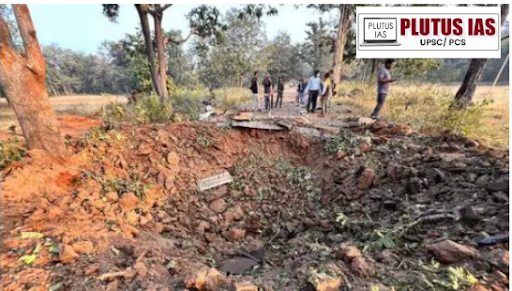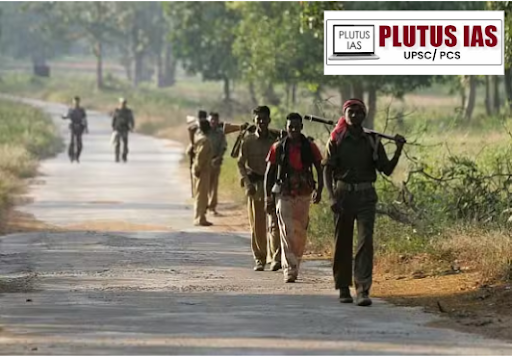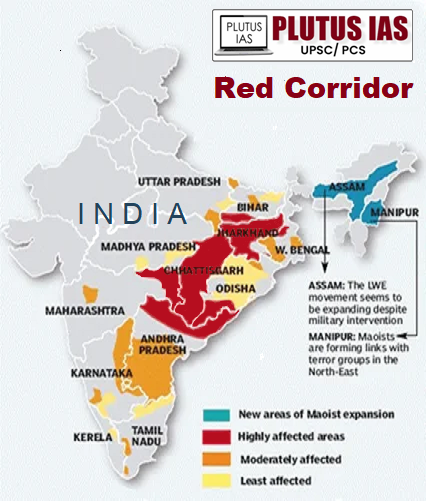07 Jan Left-Wing Extremism: A Persistent Threat to India’s Internal Security
This article covers “Daily Current Affairs,” and the topic details related to Left-Wing Extremism: A Persistent Threat to India’s Internal Security
Syllabus mapping:
GS-3: Internal Security- Left-wing Extremism is a challenge to internal security.
For Prelims:
What is left-wing extremism, what are various schemes to eradicate it, what are the manager organizations involved, what are the special operations, and what are the names of those operations?
For Mains:
How the left-wing extremism (LWE) has been originated in India?
What challenges are posed by the LWE?
what measures are taken by the government and what measures need to be taken to eradicate the LWE?
Why in the news?
On January 6, 2025, in one of the deadliest Maoist attacks in recent years, eight District Reserve Guard (DRG) personnel and one civilian driver were killed when insurgents detonated a powerful 70 kg IED under their vehicle in Chhattisgarh’s Dantewada district. The attack occurred near Aranpur village in the Kutru police station area around 2:15 PM, targeting DRG personnel returning from an anti-Maoist operation in their Scorpio vehicle.

Origin of Left-Wing Extremism
Beginnings (1967): The movement began in Naxalbari, Phansidewa, and Khoribari in West Bengal’s Darjeeling District, led by Charu Majumdar, Kanu Sanyal, and Jangal Santhal from the Communist Party of India (Marxist).
Early Revolt: It started as a peasant revolt.
Formation of CPI (M-L) (1969): Two years later, the Communist Party of India (Marxist–Leninist) was established.
Spread: Initially in West Bengal, the movement expanded to rural areas in southern and eastern India, including Telangana, Andhra Pradesh, Odisha, and Chhattisgarh.
Current Groups: Most Naxal groups trace their roots to CPI (M-L). The Maoist Communist Centre (MCC) was formed in 1975 and merged with the People’s War Group in 2004 to create CPI (Maoist).

Prevalence of Maoism in India
History: Maoist attacks, or Left-Wing Extremism, have been present in India for about 50 years.
Casualties: Approximately 15,000 lives have been lost due to Naxal violence in the last 25 years.
Early Movement: The movement started in the 1960s, led by Charu Mazumdar. It seemed to wane after he died in 1972.
Revival: Despite setbacks, the People’s War group formed in 1980 kept the movement alive. The merger of the People’s War and MCC in 2004 led to the formation of CPI (Maoist), which revived and spread the movement.
Current Status: As of February 2019, Maoist extremism affects 90 districts across 11 states in India, known as the Red Corridor.

Factors Responsible for the Rise of Left-Wing Extremism (LWE)
Tribal Dissatisfaction: The Forest (Conservation) Act of 1980 restricted tribes from using forest resources crucial for their livelihoods, leading to dissatisfaction.
Displacement: Development projects, mining, and other initiatives have displaced tribal populations in LWE-affected areas.
Exploitation of Vulnerable Individuals: Those without sustainable support are more likely to join the Naxalite movement, which recruits them by offering weapons, money, and resources.
Socio-Economic Gaps: The government often measures success based on reduced violence rather than focusing on long-term developmental efforts in affected areas.
Lack of Technical Intelligence: Ineffective strategies against Naxalism result from insufficient technical intelligence and information.
Poor Post-Control Administration: After police regain control, essential services often fail to reach local populations, leaving them unsupported and vulnerable.
Confusion in Approach: There is a lack of consensus on whether Naxalism should be addressed as a social issue or a security threat. State governments often view it as a central government responsibility, leading to insufficient local proactive measures.
Government Initiatives to Fight LWE:
| Scheme/Initiative | Details | Success/Impact |
|---|---|---|
| Operation Green Hunt | Large-scale deployment of security forces in Naxal-affected areas. | Reduced insurgency in some regions but faced criticism for collateral damage and lack of long-term impact. |
| Aspirational Districts Programme | Rapidly develops districts lagging in health, education, and infrastructure. | Improved HDI indicators in many districts but challenges in sustaining development remain. |
| SAMADHAN Doctrine | Comprehensive strategy focusing on leadership, intelligence, technology, and cutting financing. | Enhanced coordination among agencies and targeted operations, but requires deeper focus on socio-political roots. |
| ROSHNI Initiative | Trains and places rural youth from 27 LWE-affected districts under a skills development program. | Empowered youth through job placements, reducing vulnerability to Naxal recruitment. |
| Road Connectivity | Sanctioned 17,462 km of roads; 11,811 km completed. | Improved access to remote areas, boosting economic opportunities and security operations. |
| Mobile Connectivity | Installed 2,343 mobile towers in the first phase; 2,542 towers planned for the second phase. | Strengthened communication in remote areas, improving governance and reducing isolation of communities. |
| Ekalavya Residential Schools | 245 schools sanctioned in 90 LWE-affected districts; 121 operational. | Provided quality education and infrastructure for tribal children, fostering better opportunities. |
| Financial Inclusion | Opened 1,258 bank branches, 1,348 ATMs, and 4,903 post offices in worst-hit districts. | Increased financial access for marginalized communities, promoting economic inclusion and reducing extortion reliance. |
Issues Limiting the Elimination of Left-Wing Extremism (LWE) in India
1. Expansion and New Developments
Spread to New Areas: Naxal groups are extending their influence to previously unaffected regions, complicating containment efforts.
Increased Militarization: Enhanced weaponry and tactical sophistication pose a significant challenge to security forces.
Targeted Killing of Informers: Systematic elimination of suspected informers disrupts intelligence gathering.
Propaganda and Engagement: Heightened use of civil society groups, social media, and urban networks to propagate their agenda.
Urban Penetration: Efforts to infiltrate urban centers and mobilize working-class movements.
Over-Ground Organizations: Creation of legitimate-seeming organizations to support extremist objectives.
Use of Technology: Advanced communication and propaganda methods hinder interception efforts.
Large-Scale Extortion: Industries and contractors in Naxal-dominated areas are frequently extorted, funding insurgent activities.
2. Challenges in Government Measures
Intelligence Gaps: Traditional intelligence methods, such as police receivers, are inadequate against evolving Maoist tactics.
Large Troop Operations: Despite deploying larger forces, recent attacks reveal operational vulnerabilities.
Trust Deficit: Cultural differences and perceived indifference by security forces erode trust with local populations.
Protection of Informers: Failure to protect informers leads to fear, reduced cooperation, and loss of critical intelligence.
Overemphasis on Security Measures: Excessive focus on militarized responses neglects the socio-economic and political causes fueling extremism.
Political Support: Covert backing from local politicians undermines anti-LWE efforts and fosters insurgency.
Way Forward
Peace Agreements: The government and Maoists should negotiate peace agreements similar to the Mizo Accord.
Comprehensive Development: Ensure all-round development of Naxal-affected areas.
Local Engagement: Employ more local personnel in administrative roles to bridge the trust deficit and involve civil society in supporting tribal communities.
Small-Scale Operations: Use small, efficient teams like the Greyhounds for better results.
Careful Policy Implementation: Implement policies that provide indirect benefits, such as the Forest Rights Act, of 2006, with careful consideration.
IED Prevention: Develop innovative measures to prevent IED-related incidents.
Capacity Building: Focus on capacity-building and modernization of local police forces.
Surrender Policy: Rationalize surrender policies to reintegrate individuals caught in LWE into mainstream society.
Focused Approach: Adopt a time-bound approach to eliminate LWE groups and ensure comprehensive development of affected regions.
Youth Unemployment: Address the youth bulge and unemployment issues to prevent internal security threats.
Synchronized Efforts: The Centre and states must work together to eliminate radicalization and support affected populations.
Conclusion:
Effectively addressing LWE requires a holistic approach, focusing on socio-economic development alongside security measures. Tackling poverty and tribal grievances undermines extremist ideologies, while infrastructure development counters Maoist propaganda and fosters growth. In a democracy with legitimate grievance redressal mechanisms, violence-based ideologies are unsustainable. A balanced strategy integrating development and security is vital for lasting peace and stability.
Download Plutus IAS Current Affairs (Eng) 07th Jan 2025
Prelims Question:
Q. What was the main objective of the Operation Green Hunt initiative?
A. Training rural youth in skill development
B. Large-scale deployment of security forces in Naxal-affected areas
C. Promoting financial inclusion in tribal regions
D. Building educational infrastructure in LWE-affected districts
Answer: B
Mains Question:
Q. Analyze the effectiveness of government initiatives in tackling LWE and suggest measures to address its socio-economic and political roots.
(Answer in 150 words)




No Comments